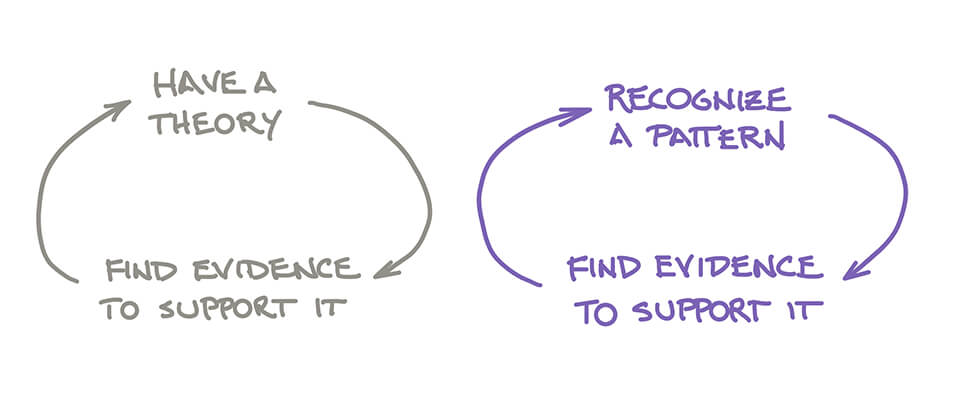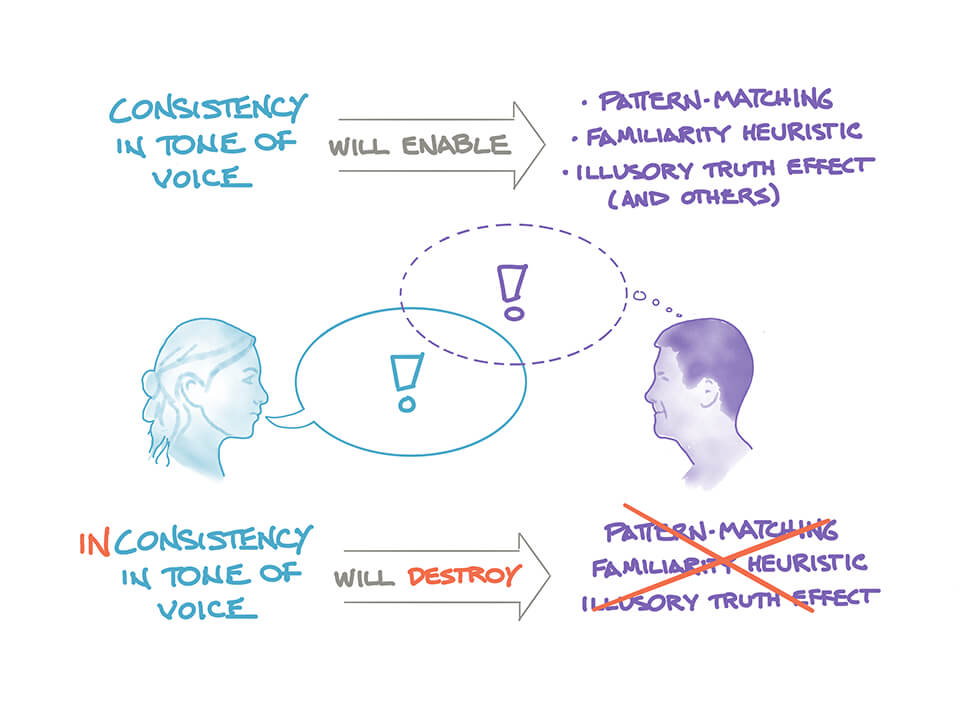The Power of Tone of Voice in Life Science Marketing – Part 5
By David Chapin
SUMMARY
VOLUME 11
, NUMER 6
Tone of voice is a powerful tool for differentiating your life science offerings. In the previous issue, I discussed how tone of voice can be guided by archetypes. I also reviewed some experiments demonstrating the self-reinforcing nature of archetypal patterns. This self-reinforcement plays a crucial role both in enabling archetypes to guide tone of voice and allowing a particular tone of voice to be understood as a component of an archetype’s pattern. In this issue I build on those topics by looking at other patterns, biases and heuristics that support the need for consistency when using tone of voice in your life science marketing efforts.
Archetypes are self-reinforcing patterns.
The self-reinforcing nature of these patterns means that archetypes are incredibly efficient marketing tools. We don’t have to send the entire pattern for our audiences to “receive” the entire pattern. They’ll perceive some of the pattern and fill in the rest on their own.
Confirmation bias helps reinforce archetypal patterns.
Figure 1. Confirmation bias is a powerful force shaping the way we perceive the world. It applies generally, but the importance to our discussion is its relevance to the recognition and reinforcement of archetypal patterns.
We all have this confirmation bias—a tendency to interpret evidence as confirmation of what we already believe to be true. The patterns we see are reinforced by our beliefs, and our beliefs help reinforce the evidence we see in the world.
How does this apply to the use of archetypes? Archetypes are patterns. Once we begin to recognize a particular pattern, each of us will look for evidence that supports it. If you believe your colleague fits the pattern of hard-working and dedicated (a Good Teammate archetype, perhaps?), you’ll find additional evidence to support this belief. And if you believe a company takes great care of their customers (Caregiver archetype, anyone?), then you’ll be more inclined to seek—and find—evidence that supports this belief.
The familiarity heuristic helps reinforce archetypal patterns.
There is a corollary to the familiarity heuristic; the illusory truth effect is the tendency to believe that information must be true after repeated exposures. In other words, saying something over and over encourages people believe that it must be true. That’s not because the information is actually true, but because people judge “truth” using a couple of yardsticks: first, whether the information lines up with their understanding, and second, whether the information feels familiar (the familiarity heuristic is also at work here).
The relationship between truth and consistency.
Saying something over and over can predispose people to find the information familiar, which helps them judge the information as true. There are plenty of current examples (in politics and advertising) where the information presented is demonstrably not true. I’m not suggesting you pursue the path of making untrue claims, and then repeating them often enough to make them feel like they might be true. In fact, one of the key criteria when crafting your position is that your claims must feel authentic.
We don’t have to look very far to find the disastrous consequences of making inauthentic claims. VW espoused values including: a “sense of responsibility”. Their mission statement highlighted their commitment to creating “environmentally sound vehicles”. But we all know what happened to VW: billions of dollars in fines and enormous damage to their reputation.
My point in discussing the familiarity heuristic and the illusory truth effect is simply that there are many mechanisms by which your audiences will judge the validity of the information, patterns or claims you present to them. If you are repeatedly making claims and sending messages that your audiences understand to be valid, the familiarity heuristic and illusory truth effect will help your audiences believe these claims. If your claims are authentic, your marketing efforts will only be helped by the consistency you employ.
The application to archetypes and tone of voice should be obvious. We must be as consistent as we can be with our tone of voice—in order to help our audiences notice, understand and internalize the pattern we’re presenting to the world.
The importance of consistency in creating the proper tone of voice.
Consistency, consistency, consistency!
In real estate, it’s a cliché that the three things that matter most are “location, location, location.” The point is that there aren’t three things that matter, there’s one thing that eclipses everything else.
In the implementation of marketing, it’s reasonable to claim that the three things which matter most are “consistency, consistency, consistency.” Here too, there’s really just one factor eclipsing everything else.
Why is consistency so crucial? Because our audiences are surrounded by lots of marketing noise. As a result, they’ve developed noise-cancelling filters in their heads. It’s really hard to cut through these filters and send them a message which they won’t be able to ignore. Consistency helps us do this; by being consistent we increase the chances that our audiences will actually hear and understand our message. This happens through many mechanisms, including the familiarity heuristic and others. Inconsistency, on the other hand, makes it more difficult for the message to get through, and if it does, makes it less memorable.
Figure 2. Inconsistency in tone of voice will negate any possible effects from our audiences’ pattern matching abilities, and other mechanisms, such as the familiarity heuristic, the illusory truth effect, and the other biases and heuristics that enable our audiences to complete our marketing messages for us.
Consistency comes from everywhere.
Because audiences are so sensitive to your tone, they’ll pick up your tone from everywhere, including—but not limited to—each of the following marketing touchpoints:
- website
- press releases
- collateral (e.g., brochures)
- email blasts
- content (e.g., white papers)
- trade show booth
- etc., etc.
But that’s not all. They’ll also be listening to your employees everywhere they encounter them, including:
- sales presentations
- webinars
- podium presentations
- LinkedIn posts
- social media posts
Your audience’s impression of your tone of voice comes from everywhere, so everything has to work together. Saying something out of character can hurt you. If you come across as super helpful (and almost obsequious) in one touchpoint, but an expert (with a touch of arrogance) in another, and a fun-loving neighbor (who can’t keep track of details, like where they put the borrowed hedge clippers) in still another, you’ll confuse your audience.
Figure 3: If you’re going to implement tone of voice, you’ve got to do it consistently. Otherwise you risk audience confusion.
The key takeaway from all of this? If you’re going to implement tone of voice, you’ve got to do it consistently.
You’ve already got a tone of voice.
By default, you already have a tone of voice. This occurs whether you’ve made a conscious choice to employ a particular tone of voice or not. A corporate tone of voice is a little like an individual’s personality; everyone has one, but only some people have chosen deliberately to shape the personality they present to the world. Tone of voice is the same; everyone has one, but only some people have chosen to deliberately shape it.
If you’re not actively controlling your tone of voice, you may come across as inconsistent, schizophrenic, generic, confused or even cacophonous. This is particularly relevant when you consider social media, such as LinkedIn, and all the other channels that individual employees use to speak on behalf of your organization, either deliberately or unwittingly.
Krulak’s Law and the importance of consistency.
US Army General Charles Krulak recognized the importance of front-line troops in nation building and counter insurgency. He theorized that “in an age of always-on cameras, cell phones and social networks, the lowly corporal in the field would have far more leverage and impact than ever before.”
And this is my topic for next time: getting all employees to use a similar tone of voice. This sounds wonderful and yet once you think about methods to implement this in the real world, it begins to look quite challenging: How exactly do you do that?
The Marketing of Science is published by Forma Life Science Marketing approximately ten times per year. To subscribe to this free publication, email us at info@formalifesciencemarketing.com.
David Chapin is author of the book “The Marketing of Science: Making the Complex Compelling,” available now from Rockbench Press and on Amazon. He was named Best Consultant in the inaugural 2013 BDO Triangle Life Science Awards. David serves on the board of NCBio.
David has a Bachelor’s degree in Physics from Swarthmore College and a Master’s degree in Design from NC State University. He is the named inventor on more than forty patents in the US and abroad. His work has been recognized by AIGA, and featured in publications such as the Harvard Business Review, ID magazine, Print magazine, Design News magazine and Medical Marketing and Media. David has authored articles published by Life Science Leader, Impact, and PharmaExec magazines and MedAd News. He has taught at the Kenan-Flagler Business School at UNC-Chapel Hill and at the College of Design at NC State University. He has lectured and presented to numerous groups about various topics in marketing.
Forma Life Science Marketing is a leading marketing firm for life science, companies. Forma works with life science organizations to increase marketing effectiveness and drive revenue, differentiate organizations, focus their messages and align their employee teams. Forma distills and communicates complex messages into compelling communications; we make the complex compelling.
© 2024 Forma Life Science Marketing, Inc. All rights reserved. No part of this document may be reproduced or transmitted without obtaining written permission from Forma Life Science Marketing.



